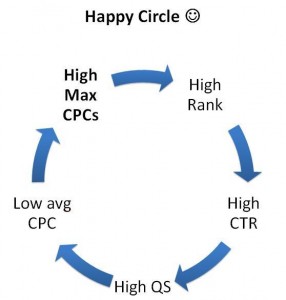Search engine marketing (SEM) is a discipline whereby search marketing professionals negotiate their way through a bidding exchange (for example, Google Adwords). Each professional tries to ensure their client’s brand shows up (ranks) on page 1 of Google’s search results listings for their business’ desired keywords. For example, if you’re a car manufacturer, you will most likely build your paid search strategy around users typing in keywords such as “cars for sale + hatchback + location, NSW”.
When building out your paid search campaign, you will start with a list of keywords that relate to your website content (hopefully, specific keywords for each page you want searchers to click through to). You will then keep expanding your keyword list to provide you with the largest possible combination of words that people looking for your product or service may use to find you.
Then you will have to create search ad text. When a user searches for one of your keywords, the text ads you prepared will be listed in the sponsored ads section (across the top or on the right hand column) of Google’s search results page. The rank of your ad will depend on your search bidding strategy.
One of the elements in your bidding strategy will be your maximum cost per click (CPC$) bid. You must enter a cost per click bid for every keyword in your search campaign. Your ad text, the information mentioned above, should relate to the keyword the user has typed in and hopefully entice them to click on your business’ ad instead of your competitors’ ad.
The combination of your CPC and your ad text will result in a click through rate (CTR%), and a quality score. Your click through rate is calculated by the number of times users’ have clicked on your ad text divided by the number of times your ad text has shown up in Google’s search results. The click through rate (CTR%) indicates to Google how relevant your ad text is to the users’ keyword, basically, it shows how popular your ad is. Google wants to give its users the best possible search results, so the more popular your ad is, the better your quality score will be.
Of course there are other elements that make up your search quality score, such as your bounce rate %. The bounce rate measures how many times users click on your ad text but then return straight to Google – indicating that the page they clicked through to was not what they were looking for. The bounce rate is an indication of how relevant your landing page or click through URL (that you assign to your ad text) is to the ad text content. Basically, you want the keyword, ad text and landing page/ click through URL all to be related to one another and contextually relevant.
How to build a successful paid search campaign?
To have a successful paid search campaign (success = a campaign that generates more revenue than it costs) you must be constantly monitoring your keywords and ad text. A winning search campaign can easily come undone if your competitor makes a change to their ad text or CPC$ bidding strategy, meaning they overtake you and your CTR% drops and you get less clicks. If you want to regain your former success, you have to change as well. This happens every day in the search world.
For those of you who are still learning search engine marketing, click here for a more information about paid search bidding strategies and detailed explanations of what some of this search marketing terminology means and they key ingredients you will need to know to build your search strategy.


Trackbacks/Pingbacks